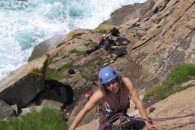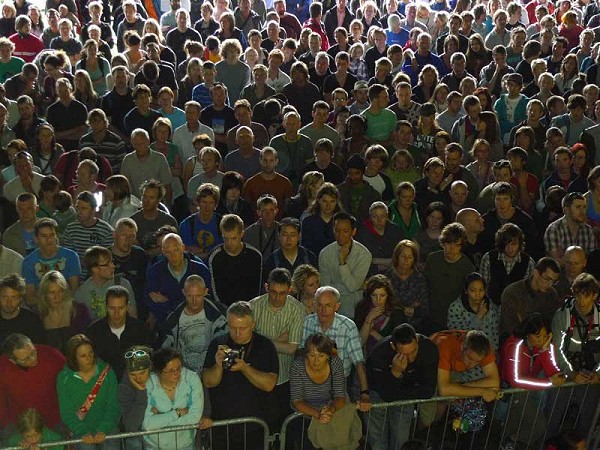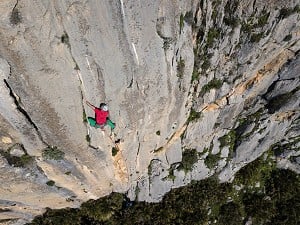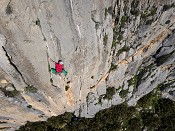
Female climber with own gear seeks: trustworthy person with good social skills to spend time with on a crag. Reasonable hygiene and slim build preferred. GSOH essential. Ownership of rope an advantage.
Ever been to that desperate place where all that's between you and a bad fall is luck – and it's the one thing you're short of? Slick with the sweat of fear you glance down at the only friend you have and find them staring away into the distance, oblivious to your strangulated "watch me". They're away with the fairies - or maybe Brad Pitt, or even a fantasy bacon sandwich.
Finding the perfect climbing partner is a tortuous quest. We're prepared to settle for second, third or fourth best, but we know how much more we can get out of a trip to the crag with that idealised 'one'. Occasionally they appear in our lives – only to be snatched away by girl/boyfriend, parenthood or job.
What makes a perfect partner? - A mutual understanding of 'safety', positive physical attributes, and lastly and not least, good character.
A similar 'discomfort zone' is required. Unfortunately 'safe' and it's inverse, 'risk', are both relative concepts. It's like when you first start living with someone – you discover they can't see the sticky smears all over the cooker and can ignore the fetid smell in the fridge, or, at the other end of the spectrum, they feel it's necessary to hoover every day and iron their pants. It doesn't take long to find out if you 'see' the risk in the same way as your partner. A belay made from a sling thrown over a pile of stones doesn't fill me with confidence, and nor does a keen amateur with a shiny new rack and HVS ambitions.
When it comes to positive physical attributes, aesthetics aren't important here (that's a bonus), but at the very least their build shouldn't make you feel either like Goliath or an anorexic fashion model when you stand next to them. There should be a degree of parity in weight. I can belay big people if I need to, but it's hard work and adds to the risk of a major fall going wrong - for both of us. Grippy gloves and an anchor that would have saved the Titanic do help, but why struggle?
“Good personal hygiene is a major consideration...”
A voice that can be heard is usually a bit important – the dulcet tones of a nymph or a muffled animal growl both get lost in the wind that invariably surrounds a crag. Even so, maybe the ideal is a partner so in tune with you that climbing calls can be a thing of the past - I know someone who found the 'one', and, after climbing many routes together, they only needed a nod and a wink to let each other know what they were about.
Good personal hygiene is a major consideration if you're spending days alone together, especially on multi-pitches when being squished up together on a very small ledge is unavoidable. Being in such close proximity can be a bit traumatic at the best of times (unless the concept of the 'one' has been taken too seriously) but having to deal with dog-breath or rank body odour can add to the level of post-traumatic stress. I take great pains to avoid anyone who professes a liking for polyester T-shirts and who considers it reasonable to wear them for more than one day – a mutual 'smell discomfort zone' between partners is also required.
But a perfect partner is someone who's more than a safe belayer with good oral hygiene. Simply put, they need to be compatible - someone you enjoy spending climbing time with. A good sense of humour is a must. Someone who walks around looking like an MP embroiled in an expenses claim investigation puts a downer on the day. I don't mind the occasional offload of dark personal life, but a cliff probably isn't a good place for amateur counselling. And anyway, a good sense of humour doesn't just help the time pass amiably: it's probably saved many a mountaineer's mental health in the murky midst of an 'epic'. A moaner and whinger is just as bad, if not worse – high irritation levels at a crag can be a dangerous thing.
I want banter not bossiness. Bossy Boots are control freaks who come to the crag with their own agenda and will get pissy if it has to be changed. They're the ones who are very precise about their routines, probably with an anal fixation about the 'right' way to coil a rope - not my thing, but there'll be someone out there who appreciates their approach. Equally, someone keen to complete as many routes as possible in a day, would probably find my desire to 'sit and look at the view for a bit' thoroughly annoying. A similar approach is crucial.
Similar climbing ability doesn't have to be a prerequisite. A complete amateur and an experienced hack can have power relationship issues but otherwise it really depends what each brings to the party. I like to be inspired - through friendly competition, encouragement or an understanding of each other's strengths.
Encouragement is a great thing, particularly when you're out of your comfort zone. I recall on-sighting a scary and difficult (for me) overhanging route, to hear the words from below: 'Your footwork let you down.' Respecting and understanding each other's limits avoids these tense moments and can be a major part of skill progression. Sometimes you need that bit of nagging to push yourself – as long as they know when to stop. Being able to say 'No' without being derided for the rest of the day and your 'unmanliness' passed on to all and sundry is just as important.
“Climbing with a member of the opposite sex can be a good thing: flirtation is fun at the crag”
Climbing with someone who over-estimates your ability is risky – I've been sent up a few routes that I've been told I'd 'love' only to end up as a gibbering wreck half way up: experiences that almost put me off climbing completely.
The sex of your perfect partner shouldn't matter. Climbing with a member of the opposite sex can be a good thing: flirtation is fun at the crag, as long as it's not distracting, and provided you both know where the line is (and let your spouses or girl/boy friends know that there's a line too). It's just another form of banter. But too much unwarranted attention can be a bad thing: having someone lech at your bottom on every route is very wearing (and that goes for both sexes).
(A word of warning: don't entertain the idea that your best loved can be your perfect climbing partner. That way madness lies (and solicitor's bills if you're married).)
What we seek is the Batman to our Robin, the Homer to our Marge, the Ren to our Stimpy - that indispensable other who is our co-conspirator, companion and protector. And it would be good, once we'd found them and once the relationship was tried and tested, that they'd show a degree of commitment and stick around.
- The Aspirant Mountaineer - Grooved Arete - Tryfan 25 Oct, 2013
- 'All Rounder' Rock Shoes 29 Jun, 2011
- Zamberlan GT RR Torre Women's Boots 23 Feb, 2011
- Ice Maidens 15 Feb, 2011
- Mountain Equipment Women's Combin Trousers 2 Jan, 2011
- COMPARISON REVIEW: Women's Soft Shell Jackets 27 Oct, 2010
- La Sportiva Cliff 5 Rock Shoes 1 Oct, 2010
- How do YOU like it? Fast or slow? 21 Oct, 2009
- A Beginner?s Guide to the Art of Seconding 12 Jul, 2009
- Belay Bunnies and Gear Tarts 9 Jun, 2009

















Comments